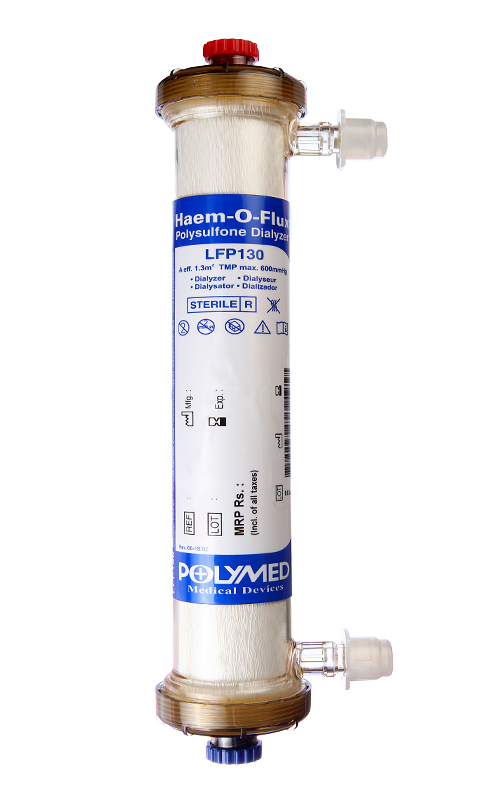Dialyzers
Living On Dialysis Can Be Challenging Haem-O-Flux Brings “New Normals” In Your Life
Haem-O-Flux is the first member of our Haem-O-Flux family. Due to its asymmetric membranes & uniform pore distribution this series remains one of the highest performing low flux dialyzers available today. At the earliest of its siblings this series has helped to build the credibility of the Haem-O-Flux name which now enjoys the trust of customers.
Haem-O-flux
Dialyzers
Features & Benefits:
- Ultra-smooth PU cut surface reduces blood clotting
- Uniform distribution of pore size for higher clearance
- Excellent membrane bio-compatibility
- Optimized asymmetric membrane structure
- Shelf Life: 36 Months
- Available variants: Low & High Flux
Technical Specifications: Haem-O-Flux LFP 130
| Surface Area (m²) | 1.3 |
| KUF* (mL/h*mmHg) | 12 |
| Form of Treatment | HD |
| Wall Thickness/ Lumen | 40/200µm |
| Membrane | Polysulfone |
| Housing | Polycarbonate |
| Potting Compound | Polyurethane |
| Priming Volume (mL) | 79 |
| Sterilization | Gamma |
| TMP Max. mmHg | 600 |
| Product Code | 90365 |
| Units per Box | 28 |
Clearance QB 200 mL/min
| Urea | 12 |
| Creatinine | HD |
| Phosphate | 40/200µm |
| Vitamin B12 | Polysulfone |
Clearance QB 300 mL/min
| Urea | 241 |
| Creatinine | 214 |
| Phosphate | 169 |
| Vitamin B12 | 98 |
In vitro performance : Qd=500 ml/min, Qf= 10 ml/min, T= 37°C. Bovine blood Hct 32%, Protein 60g/LIn vitro performance : Qd=500 ml/min, Qf= 10 ml/min, T= 37°C. Bovine blood Hct 32%, Protein 60g/L
Our Blogs

Polymed Receives ‘India Medical Devices Company of the Year’ Award
The Award, presented by the Government of India, underscores Polymed’s continued leadership position in Medical devices sector Polymed focuses on tapping huge potential in Domestic ...
Read More
Read More

Fundamentals, Lets Go Back to Basics
Polymed announces the Academic Initiatives in collaboration with Infusion Nurses Society, India on nursing practices for good nursing care. As the work of nursing becomes ...
Read More
Read More

Guarded fistula needle reduces Needle Stick Injuries in Haemodialysis Units
Needle Stick Injuries are injuries caused by accidental penetration of the skin by an injection needle. Globally, NSI’s are the most common source of occupational ...
Read More
Read More
